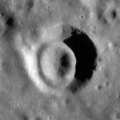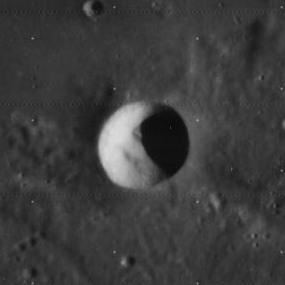
Bancroft is a small, bowl-shaped impact crater located to the southwest of Archimedes on the Mare Imbrium. A wide, shallow depression runs from the rim of Bancroft southeast to the Montes Archimedes. There are some clefts at the edge of the mare to the west and southwest of the crater. Other prominent craters are two small craters nearly to the west named Feuillée and Beer.

Alpetragius is a lunar impact crater located on the eastern edge of Mare Nubium, to the southwest of the much larger crater Alphonsus. In the southeast is the prominent crater Arzachel, and to the west lies the flooded Lassell. Alpetragius is a Latinization of the name of Nur ad-Din al-Bitruji, a Spanish-Arab astronomer.

Cleomedes is a prominent lunar impact crater located in the northeast part of the visible Moon, to the north of Mare Crisium. It was named after Greek astronomer Cleomedes. It is surrounded by rough ground with multiple crater impacts. The irregular crater Tralles intrudes into the northwest rim. To the east is Delmotte. North of Cleomedes is a triple-crater formation with Burckhardt occupying the center.
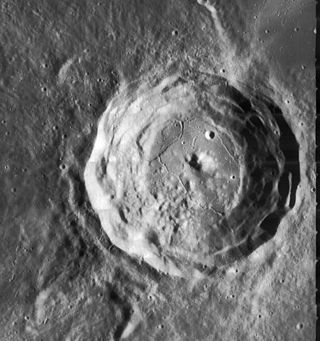
Cardanus is a lunar impact crater that is located in the western part of the Moon, in the western part of the Oceanus Procellarum. Due to its location the crater appears very oval because of foreshortening, and it is viewed almost from the side.

Doppelmayer is the remains of a lunar impact crater that lies on the southwest edge of Mare Humorum. It was named after the German mathematician and astronomer Johann Gabriel Doppelmayr. To the south-southeast is another flooded crater designated Lee, and to the southeast is Vitello. Just to the east-northeast of Doppelmayer lies the nearly submerged crater Puiseux.

Agatharchides is a lunar impact crater located at the southern edge of Oceanus Procellarum, in the region between the Mare Humorum and Mare Nubium. To the east-southeast is the crater Bullialdus, and to the south-southwest lies Loewy. It is named after the Greek geographer Agatharchides.

Archytas is a lunar impact crater that protrudes into the northern edge of Mare Frigoris. To the northwest is the comparably sized crater Timaeus, and the smaller Protagoras lies in the opposite direction to the southeast. Further to the southwest, beyond the opposite edge of the mare, is the dark-floored crater Plato.

Boss is a lunar impact crater that is located along the northeast rim of the Moon's near side. Due to its location, the crater is viewed from the side by observers on the Earth, and its visibility is subject to libration effects. It was named by the IAU in 1964 for astronomer Lewis Boss.

Belʹkovich is a large lunar impact crater of the form termed a walled plain. The formation has been heavily eroded by a history of subsequent impacts, leaving it reshaped, worn, and the features softened and rounded. Belʹkovich is located along the northeastern limb of the Moon, and so its visibility is subject to libration effects. From the Earth this crater is viewed from the side, making it difficult to view it in detail.
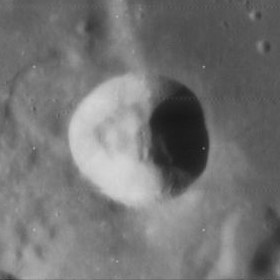
Bellot is a small lunar impact crater that is located on the southwest edge of Mare Fecunditatis. It lies between the craters Goclenius to the northwest and Crozier to the southeast. To the southwest is Colombo, and to the west is Magelhaens.

Blackett is a lunar impact crater that lies on the far side of the Moon, behind the southwest limb. It lies beyond the southeast outer ring of the immense Mare Orientale basin. The formation of that major feature has left Blackett deeply marked with ridge features trending from the northwest. Much of the crater has been shaped by the ejecta from Mare Orientale, particularly along the western half of the crater.

Brunner is a lunar impact crater that is located along the eastern limb of the Moon, to the southeast of the Mare Smythii. At this location the crater is viewed from the edge, and so it is not possible to see much detail from the Earth. The visibility of this formation is also affected by libration. The crater lies to the southwest of the walled plain Hirayama, and to the east of the elongated crater Houtermans.

Loewy is a small lunar impact crater that lies along the eastern rim of Mare Humorum, in the southwest part of the Moon's near side. It was named after French astronomer Maurice Loewy. This is a lava-flooded formation that lies to the southwest of the larger, lava-flooded crater Agatharchides. To the southeast is an even larger lava-flooded formation, Hippalus.

Cook is a lunar impact crater that lies in the western part of the Mare Fecunditatis, just to the southeast of the prominent crater Colombo. To the southwest is Monge.
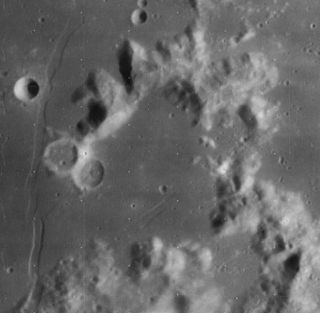
Hall is a lunar impact crater in the southeast part of the Lacus Somniorum, a lunar mare in the northeast part of the Moon. It was named after American astronomer Asaph Hall. This feature can be found to the east of the prominent walled plain Posidonius. Just to the south, and nearly attached to the southern rim of Hall is the smaller crater G. Bond.

Catalán is a small lunar impact crater that lies almost along the southwest limb of the Moon. At this position the crater is ill-suited for observation from the Earth as it is viewed almost from the side, and visibility is subject to libration effects. It lies to the west of the somewhat larger crater Baade, and south-southeast of Graff. This region is located in the outer southeastern part of the skirt of ejecta that surrounds the Mare Orientale impact basin, and the nearby surface is rugged and streaky. This crater is named after the Spanish scientist Miguel Antonio Catalán Sañudo (1894–1957) for his contributions to spectroscopy, an important exploratory tool in astronomy.
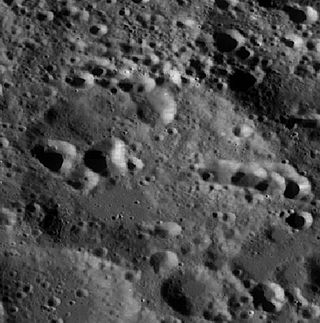
Chandler is a lunar impact crater in the northern hemisphere, on the Moon's far side. It lies to the southeast of the large walled plain D'Alembert, and southeast of the slightly smaller Chernyshev crater.

McClure is a small lunar impact crater. It is located along the western edge of the Mare Fecunditatis, due east of the prominent crater Colombo. To the north of McClure is the similar Crozier, and to the southwest is the larger Cook. The outer rim is nearly circular and not significantly worn. The inner walls slope down to a somewhat irregular interior floor. McClure C is attached to the exterior of the northwest rim.

Erro is a lunar impact crater that lies beyond the eastern limb of the Moon, on the far side as seen from the Earth. It lies along the eastern fringes of the uneven plain that joins Mare Marginis to the northwest with Mare Smythii to the west-southwest. This part of the surface is sometimes brought into sight of observers on the Earth due to libration. However even at such times not much detail can be seen, as the surface is viewed from the edge.
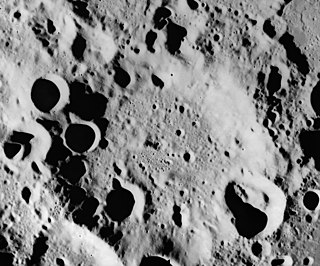
Titius is a lunar impact crater that is located on the Moon's far side, beyond the eastern limb. It lies to the west of the Lacus Solitudinis, a small lunar mare. Less than a crater diameter to the north east is the crater Bowditch, and farther to the southwest is Donner.




